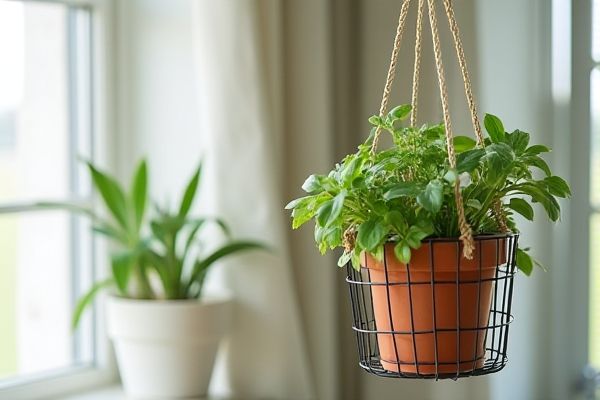
Wire basket planters offer excellent drainage and breathability for your plants, making them ideal for outdoor use and quick drying after rain. Hanging terracotta pots provide a classic aesthetic with their porous material that retains moisture slower, perfect for indoor or shaded areas; explore the rest of the article to find out which option suits your gardening needs best.
Table of Comparison
| Feature | Wire Basket Planter | Hanging Terracotta Pot |
|---|---|---|
| Material | Metal wire frame with liner | Terracotta clay |
| Weight | Lightweight | Heavier |
| Drainage | Excellent, often lined with coco coir | Good, natural porosity with drainage holes |
| Air Circulation | High, promotes root aeration | Moderate |
| Durability | Rust-prone if not coated | Fragile, prone to cracking |
| Design Versatility | Open, customizable shape | Classic, solid shape |
| Maintenance | Requires liner replacement | Low, but careful handling needed |
| Best Use | Outdoor plants requiring good drainage and airflow | Indoor or sheltered outdoor hanging plants |
Introduction to Wire Basket Planters and Hanging Terracotta Pots
Wire basket planters provide excellent drainage and airflow, making them ideal for vibrant, healthy plants, especially in outdoor settings. Hanging terracotta pots offer a classic aesthetic along with natural porosity that helps prevent overwatering by allowing soil to breathe. Both options enhance garden decor, with wire baskets supporting lined coco coir or moss for moisture retention, while terracotta pots bring durability and natural temperature regulation.
Material Composition: Metal Wire vs. Terracotta Clay
Wire basket planters are crafted from durable metal wire, providing sturdy support and excellent airflow for plant roots, which helps prevent moisture buildup and root rot. Hanging terracotta pots are made from porous clay material that allows natural breathability, promoting healthier root systems through better aeration and moisture regulation. Metal wire baskets offer lightweight flexibility and resistance to breakage, while terracotta pots deliver classic aesthetics with superior insulation against temperature fluctuations.
Aesthetic Appeal and Garden Design Impact
Wire basket planters offer a contemporary, industrial aesthetic with their open, airy design that showcases the plant's foliage and allows for creative layering of trailing vines. Hanging terracotta pots bring a classic, rustic charm with their warm, earthy tones and textured surface, enhancing traditional or Mediterranean garden themes. Your choice between these planters will significantly influence the overall garden design, balancing modern minimalism against timeless elegance.
Weight, Durability, and Longevity
Wire basket planters are lightweight and easy to move, making them ideal for flexible garden setups, whereas hanging terracotta pots tend to be heavier and require secure mounting. In terms of durability, wire baskets resist cracking and chipping better than terracotta, which can become brittle and break with temperature fluctuations. Your choice should prioritize longevity, as wire baskets often last longer outdoors due to their rust-resistant coatings, while terracotta pots need careful handling to avoid damage over time.
Drainage and Root Health Considerations
Wire basket planters typically offer superior drainage due to their open structure, which helps prevent waterlogging and promotes healthy root aeration. Hanging terracotta pots, while porous and beneficial for airflow, can retain moisture unevenly, potentially causing root rot if not monitored carefully. Proper drainage holes and watering frequency are crucial in both options to maintain optimal root health and prevent fungal issues.
Versatility and Placement Options
Wire basket planters offer greater versatility and placement options due to their lightweight structure and ability to accommodate liner materials, making them ideal for both indoor and outdoor use. Hanging terracotta pots provide a classic aesthetic but are heavier and less adaptable to various environments, often requiring sturdy support and careful placement to avoid breakage. You can choose wire basket planters for flexible decor solutions in tight spaces or hanging terracotta pots to create traditional charm with a more fixed placement.
Maintenance and Care Requirements
Wire basket planters require regular watering and occasional re-lining with moss or coco coir to retain soil and moisture effectively, making them suitable for plants that thrive in well-drained environments. Hanging terracotta pots are porous and dry out more quickly, demanding more frequent watering but offering excellent aeration for roots, which helps prevent overwatering issues. Your choice depends on the level of maintenance you prefer, as wire baskets need periodic upkeep to maintain structure, while terracotta pots require vigilance to keep plants hydrated.
Cost Comparison: Upfront and Long-Term
Wire basket planters generally have a lower upfront cost compared to hanging terracotta pots, making them a budget-friendly option for gardeners. Over time, wire baskets tend to be more durable and less prone to cracking, which can lead to lower long-term replacement costs. Hanging terracotta pots, while often more expensive initially, may require more frequent replacements due to their fragility and potential for weather damage.
Best Plant Types for Each Planter
Wire basket planters are ideal for trailing plants like ivy, ferns, and petunias, as their open structure provides ample airflow and drainage. Hanging terracotta pots are best suited for succulents, herbs, and orchids, benefiting from the pot's porous material that helps regulate moisture levels. Choosing the right planter enhances your plant's growth by matching its specific environmental needs.
Environmental and Sustainability Factors
Choosing a wire basket planter offers enhanced breathability and reuse potential, contributing to reduced plastic waste compared to plastic pots. Hanging terracotta pots are biodegradable and made from natural clay, minimizing environmental impact but can be prone to breakage, resulting in shorter lifespan and more frequent replacements. Your sustainable gardening efforts benefit most from selecting durable, recyclable materials that reduce landfill contributions and promote eco-friendly plant care.
 homyna.com
homyna.com